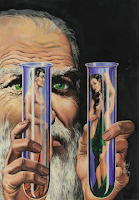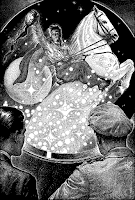 |
| the Hotel Triceratops in Tanaquil, Bethune Preserve |
Last year I took a look back at some of the humor of
Jack Vance and the theme of that blog post was, "
how to have fun with each and every story". At that time, I described six memorable characters that Vance included in stories of his
Demon Princes,
Alastor Cluster and
Cadwal Chronicles series.
For this year's celebration of the life of Jack Vance, I play tour guide for visits to six of the memorable places that Jack Vance invented for his readers.
Hotel Triceratops
In
The Book of Dreams, the erratic course of
Gersen's hunt for Demon Prince
Howard Alan Treesong brings us to the planet Bethune Preserve, with "
over 600 game and nature reserves".
Vance kept returning to the idea of an entire exoplanet that, rather than be swarmed by human settlers, would instead be protected and treated like a nature preserve. There is a hint of such thinking in
Star King, when after a long "
fantastic voyage" to reach
Tehalt's planet, the Director of Exploration and the Chairman of the Research Planning Committee for the
Department of Galactic Morphology both decide to keep the world secret, as Gersen puts it: "
...to preserve the world from desecration".
18 years later, Vance returned to this idea of a planetary nature reserve and gave us Bethune Preserve. Then, 6 years later Vance launched an entire series of novels built upon the idea of the planet Cadwal having been set aside as a world protected from human exploitation. I like to think that the events of
The Book of Dreams are located in time several centuries before those of the Cadwal Chronicles.
After centuries of existence as a Conservancy, Cadwal starts going through changes. Like a disease, the Yips (something like illegal immigrants) start to grow from their primary site of infection in the Lutwen Atoll, threatening to swarm over an entire continent.
Some of the few legal residents of Cadwal waver in their devotion to protecting the native life forms and begin to dream of setting aside the Conservancy and "civilizing" the planet. The Naturalist Society, which owns Cadwal, is almost extinct and unable to protect Cadwal as a nature preserve.
We can imagine that the
Naturalist Society of Old Earth is still quite active during Kirth Gersen's lifetime and its members frequently venture to Bethune Preserve in order to study the native life forms. Among these is the horned
Triceratops Shanar, a six legged beast that can grow to at least 20 feet in length judging from the stuffed specimen on display at the Hotel Triceratops in Tanaquil. Some of the beasts that are native to Cadwal's continent Ecce seem to be similar in nature to those depicted on Bethune Preserve.
 |
| Triceratops Shanar display at the Hotel Triceratops, a popular tourists inn of Tanaquil, Bethune Preserve |
 |
| Butterflies and Beasts on Cadwal |
Tanaquil is a major port of ingress for tourists. Somewhere between a town and a city, Tanaquil is a small urban settlement by Earthly standards. Vance had fun depicting the residents of Bethune Preserve as being held tightly in the grip of Regulations that were designed to protect the native creatures of the planet.
The entire planet of Bethune Preserve was later re-imagined by Jack Vance as the planet
Cadwal, a world completely controlled by the Naturalist Society of Earth. In his series of novels about Cadwal, Vance explored the social dynamics of groups such as Naturalists and Tourists, each with their own competing interests.
Vance lovingly elaborated upon the idea of small tourist resorts that could be integrated into the natural beauty of Cadwal while not disturbing the native life of the planet.
Islands of the Imagination
In
Trullion, Glinnes tries to romance his Hussade team's sheirl on a small island near Welgen, in the Fens. Duissane rebuffs his advances, letting loose her tongue: "
You're all alike, you Trills! You reek of cauch; your brain is a single lecherous gland. Do you aspire to nothing but turpitude?"
Writing some 15 years later, Vance brought together Glawen and Wayness on Ocean Island, one of the few sailing destinations for residents of Araminta Station on the planet Cadwal. Unable to put out of mind his irksome duties as a junior police officer, Glawen notes, "
It seems foolish to go back. We could live in utter tranquility here, at peace with the elements."
Wayness cautions, "...
you might well become bored with me after ten or twenty years- especially if we ran out of soap."
 |
| Glawen and Wayness visit Ocean Island. |
 |
| The World of the Nineteen Moons. |
Glinnes simply laughs when he receives Duissane's tongue lashing and he remains fascinated by her. Similarly, Glawen is forced to respect the currents of destiny that he and Wayness are caught up in, currents that hold them apart. Glinnes and Glawen both politely return their island guest to the mainland, but neither gives up their romantic dreams.
The Standing Stones
Wayness is too busy to give into Glawen's charms. She feels that the future of the Cadwal Conservancy and the planet Cadwal rely on her ability to find the Cadwal Charter. After much travail, she and Glawen eventually succeed in finding the Charter and saving Cadwal.
Along the way to the end of the Cadwal saga, Glawen saves Wayness from three dastardly attacks, one among the Standing Stones of planet Nion.
In the end, Glinnes and Glawen overcome the objections of Duissane and Wayness. On the last page of Trullion, Glinnes and Duissane
walk together down a beach, Vance leaving readers aware of the fact that finally nothing remains to keep the two apart.
At the end of the Cadwal Chronicles, Glawen and Wayness are building the home that they will live in together and their friend Lewyn Barduys has given them a wonderful wedding gift: a
Fortunatus Nine space yacht. After all their flirtations with danger, Wayness and Glawen are ready for some tranquility, but we suspect that before too long they will board the Frotunatus and be off on new adventures between the stars.
 |
Glisten on Dessimo Beach near Balad. Also:
the tiny hut shared by Jantiff and Glisten
near the Moaning Ocean on the planet Wyst. |
Dessimo Beach
Vance's stories feature a number of memorable beaches. For a short time, Dessimo Beach, beside the Moaning Ocean, was the home of
Jantiff Ravensroke and
Glisten, the young Weirdlands Witch.
In the Demon Princes series, Gersen frequents Sailmaker Beach, to the north of Avente, on the planet Alphanor, beside the Thaumaturge Ocean.
Dessimo Beach is nearly wild, one of the many places in the human universe where civilization has first triumphantly come, but then succumbs to a process of de-civilizing and that Vance depicts as crumbling back into nature. Not far from Balad, a small town at the extreme southern end of the Weirdlands, Jantiff makes his home by sprucing up a decayed fisherman's shack.
Reflecting on his time living on Dessimo Beach, Jantiff says, "
As I think back, I was happy there. I had food; I had Glisten to look at; I had goals, impractical though they might have been, and for a time I thought I was realizing them. Yes! I was truly alive!"
The Chailles
 |
On the dunes of Dar Sai, under
the magic light of Mirassou |
In the moonlit desert near Dinkelstown, Kirth Gersen and
Jerdian Chanseth joined the Darsh in their nocturnal mating ritual.
Jerdian and her party of Methlen tourists were tricked by their Darsh guide, Nobius. Using the Methlen as bait, Nobius wins the kitchet Farrero, who has been positioned on a rocky ledge of the Chailles.
Gersen rescues Jerdian from the Darsh and together they float over the dunes in Gersen's aircar. Under the romantic influence of the moon Mirassou, Jerdian comments, "
The desert is a very strange place by moonlight. Of gives off an enchantment like a dream-place..."
Safe in Gersen's tender embrace Jerdian asks, "
Will I be the only one returning with my virtue intact?" Gersen leaves that up to her. Under the magic moon, upon the ancient dunes, they become lovers.
Bainsey Castle
Vance spent much of his life building his house on a hillside in California. In his stories, he depicted many notable construction sites and castles. In the Cadwal saga, when the character Lewyn Barduys falls in love with Cadwal and its wilderness lodges, he sets out to build his own rustic inns.
"
The first thesis governing every inn was definite: it must be an integral part of the landscape, with no interference from elsewhere in the form of color contrasts, discordant shape, music or other entertainment."
Barduys starts to construct wilderness lodges on the planet Rosalia. For the site of his first inn, he selects the old Bainsey Castle site. Once a sea-side retreat for the Stronsi clan, the Castle lies in ruins, having been toppled by a storm. Felitzia Stronsi (Flitz), the only survivor of the Castle's collapse, becomes the love interest of a charming vagabond, Eustace Chilke.
 |
| Bainsey Castle Lodge, Rosalia. |
Eustace and Flitz were made for each other. Chilke happened to come into ownership of the Cadwal Charter. With similar lack of volition, Flitz became the owner of Stronsi Ranch. They are two free spirits and not interested in owning anything, except a space yacht that can allow them to (as Flitz puts it): "
...fly off into the far regions of space to track down the drunken tales you once heard in a saloon, while probably more than half drunk yourself and, in general, live a feckless irresponsible life."
At the end of the Cadwal Saga, Glawen and Wayness as well as Flitz and Chilke have all promised to be on Rosalia for the grand opening of the new inn being built by Barduys at
the Bainsey Castle site. Vance's fans will always be able to assemble at such far destinations, thanks to the imagination of
Jack Vance.
______________________________________
Related Reading:
More places from the imagination of Jack Vance, including
Smade's Planet. The
Fens and Airy Gulch.
Port Mar.
Stroma Fiord and Stronsi Ranch.
2016 tribute to Vance.
Next: Jack Vance
in another Reality.



























































